This post may include affiliate links. Thank you for your support.
These classic Sauteed Peppers and Onions are simple to prepare and full of rich flavor! Seasoned with garlic, spicy pepper flakes, Italian seasoning and balsamic vinegar, they are delicious as a stand-alone side, or perfect on pasta, burgers, polenta, pizza and more! It’s a versatile, healthy dish your family will love. (keto-friendly, gluten-free, paleo, vegetarian and vegan)
Table of Contents
About sautéed peppers and onions recipe
Sweet peppers and delicate yellow onions are perfectly sauteed with fragrant garlic, flavorful Italian seasoning, spicy crushed pepper flakes, fresh basil and fruity-tart balsamic vinegar. Sweet and savory, these colorful, vibrant ribbons are buttery, rich and melt-in-your-mouth tender with a beautiful fresh crispness.
Bursting with flavor, these luscious vegetables are more than just a side dish and will make a vegetable lover out of you!
You can serve them with toasted bread, grilled meats, roasted chicken, lush omelettes, fried eggs, buttery mashed potatoes, pasta, pizza and more! These uncomplicated yet bold, insanely delicious sauteed peppers and onions can completely transform a meal from something ordinary to something extraordinary!
FAQs: frequently asked questions
How should I season peppers and onions?
You can season peppers and onions with various spices! This side dish can be as bold or mild as you desire! While this recipe uses Italian seasonings, spicy pepper flakes and balsamic vinegar, I encourage you to try new things and play with your favorite spices and dry herbs!
Spice mixes to try when sautéing bell peppers with onions
- Italian Seasoning
- Cajun Seasoning
- Taco or Fajita Seasoning
- Greek Seasoning
- Sazon Seasoning
Fresh herbs to use with onions and peppers
If you’re looking for an in-depth description of fresh herbs, check out this post: 14 Types of Fresh Herbs to Use in Your Kitchen!
- Basil
- Oregano
- Parsley
- Thyme
- Rosemary
At what temperature do I sauté vegetables?
The onions and peppers should be cooked at various temperatures in order to ensure they become golden, caramelized and perfectly sautéed!
The onions are added to the pan first and cooked (sweat) over medium heat until they are just softened and slightly golden in color. The peppers are then added to the pan and the heat is increased to medium-high in order to slightly blister the skins. To finish cooking, the heat is reduced to low and the vegetables are cooked until tender and perfectly caramelized.
Can you sauté in butter instead of oil?
While you can use butter instead of oil when sautéing, I don’t recommend it. The milk solids in butter can burn which will affect the color and taste of the vegetables.
Instead, if you would like to use butter, I recommend using a combination of equal parts butter and oil.
How to easily sauté peppers and onions at home?
(Scroll down for the detailed measurements and instructions in the printable recipe card at the bottom of the page)
- Sauté onions: Heat oil in a large skillet over medium heat. Add the onions. Sauté, stirring frequently, until softened and slightly golden in color, about 8-10 minutes.
- Add peppers and seasonings: Add the peppers, Italian seasoning and crushed red pepper flakes. Increase heat to medium-high. Sauté, stirring occasionally, until the peppers are softened and slightly browned, about 12-15 minutes. NOTE: The bottom of the pan should start to develop browned bits, known as Fond during cooking. You can either use a wooden spoon to stir the vegetables into the browned bits, or add a few splashes of water, wine or broth to the pan and stir it into the vegetables. The fond is what adds a rich flavor to the dish!
- Add garlic and balsamic: Add the garlic to the pan and season with ½ teaspoon salt and ¼ teaspoon pepper. Stir well to combine. Reduce heat to low and add the balsamic. Stir again to combine. Continue to cook for 3-4 minutes, or until the vegetables are very tender.
- Add basil: Stir in the fresh basil. Taste and adjust for seasoning as desired.
- Serve: Garnish with fresh herbs and cheese if desired. Serve hot, warm or at room temperature. Enjoy!
Serving skillet peppers and onions
What to make with sauteed peppers and onions?
- Salad: Make a salad out of vegetables by adding pearl mozzarella, pine nuts, and plenty of fresh herbs. Finish the salad with a balsamic vinaigrette.
- Crostini: Top slices of toasted baguette with soft cheese such as burrata or mozzarella and a pile of peppers and onions for a quick and easy appetizer.
- Home Fries: Use leftover peppers and onions to make pan fries just like your favorite diner.
- Omelet or Frittata: Use vegetables as an easy filling for omelets and frittatas.
- Avocado Toast: Make the most of your avo toast by adding a generous serving of peppers and onions.
- Soup: Try stir peppers and onions into your favorite Italian soup recipes, like this chicken and spinach tortellini soup or soup with italian sausage for extra flavor and texture!
- Burgers and Sandwiches: Use the veggies as a topping for you favorite burgers and sandwiches.
- Quesadillas and Burritos: Try using the vegetables as a filling for quesadillas, burritos, fajitas with chicken, steak fajitas, and tacos.
- Pizza: Use them as a delicious topping for pizza pies.
- Casseroles: Add them to enchilada casseroles and Mexican chicken bakes.
What to goes with sautéed vegetables?
- Hoagies or Sub Sandwiches: Either add peppers to the top of a sub or serve them on the side.
- Polenta: A big bowl of creamy polenta pairs fabulously with Italian vegetables.
- Soups: I really love these tender-crisp peppers and onions with Italian soups, such as this soup with italian sausage or tortellini chicken spinach soup. But, it’s equally delicious with hearty soups, like this rich and creamy chicken gnocchi soup in the slow cooker or this chicken chowder recipe.
- Steak, Chicken or Sausage: Add a heaping pile of sautéed vegetables to the top of steak and chicken. Or, pile vegetables alongside baked sausages.
- Meatballs: Italian vegetables make the perfect side dish for saucy beef or chicken meatballs.
- Pasta: You can either stir the veggies into hot, buttery noodles or serve them on the side of your favorite pasta dishes, like sausage and cream pasta and baked ziti recipe with sausage.
- Risotto: Prefer creamy risotto to buttery pasta? I love these sauteed bell peppers and onions with scallop and risotto or mushrooms and risotto.
- Stir-Fries and Grain Bowls: Bulk up simple stir-fry recipes and grain bowls with perfectly tender-crisp veggies. I personally love these with apricot chicken, garlic honey chicken stir fry, and lemon chicken stir frys.
- Grilled Favorites: A pile of crisp, rich sautéed veggies pairs perfectly with all your grill favorites, like Bacon-Wrapped Hot Dogs, Grilled Shrimp Salad, Rosemary Skewered Chicken, Grilled Fajitas, Pork Tenderloin Skewers, and more.
Storing sauteed onions and peppers
Food safety is of the upmost importance when it comes to storing your leftovers! Make sure you follow the simple tips below to ensure you are properly storing, freezing and reheating your vegetables!
How long are cooked peppers and onions good for?
Leftover cooked vegetables should be stored in an airtight container or zip-closure bag in the refrigerator. Properly stored, they will last up to a week in the fridge.
Can I freeze them?
Sautéed vegetables freeze beautifully! Cooking vegetables in big batches and then freezing ensures you can add a healthy serving of vegetables to any meal!
To freeze peppers and onions
- Sauté. Sauté vegetables according to recipe instructions.
- Cool. Remove vegetables from the heat and let cool to room temperature.
- Flash freeze. Spread the vegetables out on a parchment paper lined baking sheet in a single layer so they don’t clump together. Use multiple baking sheet if needed. Transfer baking sheet to the freezer and flash freeze for about 1 hour, or until vegetables are frozen. Note: It is best to flash freeze vegetables so they are completely cooled before being transferred to storage containers. Warm vegetables will trap heat, which can alter the freezing process.
- Store. Transfer frozen vegetables to airtight containers or freezer-safe zip-closure bags. If using bags, press out any remaining air in the bag before sealing.
- Freeze. Transfer storage containers to the freezer and freeze. Vegetables will keep in the freezer for up to 4 months.
How to reheat peppers and onions?
You can either add frozen vegetables right to a recipe that will be cooked, or they can be thawed and reheated.
There are three easy ways to reheat
- Stovetop: Gently warm the vegetables in a pan over medium-low heat on the stove. Be sure to toss and stir the vegetables so they reheat evenly.
- Oven: Spread the vegetables out on a baking sheet and lightly drizzle with olive oil, balsamic vinegar or a combination of both. Reheat in an oven preheated to 425 degrees Fahrenheit for 6-10 minutes, or until vegetables are warm. If vegetables seem dry, cover the baking sheet with aluminum foil.
- Microwave: Place vegetables in a bowl and cover with plastic wrap. Gently steam in the microwave until vegetables are just warm to the touch.
Nutritional information
Are stove-top peppers and onions good for you?
Peppers and onions are a wonderful, healthy side dish option! This dish is low in calories and loaded with health benefits!
Bell peppers are high in fiber and an excellent source of vitamins A and C, folic acid and potassium. Onions are also a good source of fiber and folic acid, plus they contain vitamin B and are loaded with antioxidants.
In addition, this dish is keto-friendly, gluten-free, paleo, vegetarian and vegan. Please note, if you have strict dietary restraints, always check nutrition labels to ensure the brand you are using is safe and meets your needs.
How many calories and carbs in bell peppers with onions?
The exact number of calories and carbohydrates will depend upon the precise measurement and ingredients used. This recipe serves six and has approximately 86 calories and 9 grams of carbohydrates per serving.
These tender, rich vegetables are the perfect, versatile side dish you and your family will love! But, fair warning, they are so delicious you may find yourself eating them straight from the pan!
Cheyanne
Craving MORE? Follow all the deliciousness on Facebook, Pinterest and Instagram!
More delicious veggie side dishes!
- Pickled Onions Quick
- Caramelized Onions (in the oven!)
- Sautéed Mushrooms,
- Brussels Sprouts au Gratin
- Asparagus Mimosa
How to make the best sauteed peppers and onions👇
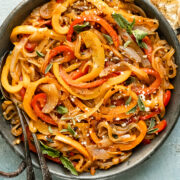
Sauteed Peppers and Onions
Equipment
- large skillet
Ingredients
- 2 TBS Olive Oil
- 2 whole Yellow Onions – thinly sliced (about 4 cups)
- 3 large Bell Peppers – stemmed, seeded and thinly sliced (SEE NOTES)
- 1 tsp Italian Seasoning – homemade or store-bought
- ¼ - ½ tsp Crushed Red Pepper Flakes
- Kosher Salt & Ground Black Pepper - to taste
- 2 cloves Garlic – peeled & finely diced
- 1 TBS Balsamic Vinegar (SEE NOTES)
- ¼ Cup Fresh Basil Leaves – torn or chiffonade, plus more for garnish
- Optional Garnishes: Fresh Oregano, Fresh Parsley, Grated Parmesan, Mini Mozzarella Pearls
- Optional for Serving: Crusty Bread, Sausages, Reduced Balsamic
Instructions
- Sauté onions: Heat oil in a large skillet over medium heat (SEE NOTES). Add the onions. Sauté, stirring frequently, until softened and slightly golden in color, about 8-10 minutes.
- Add peppers and seasonings: Add the peppers, Italian seasoning and crushed red pepper flakes. Increase heat to medium-high. Sauté, stirring occasionally, until the peppers are softened and slightly browned, about 12-15 minutes. NOTE: The bottom of the pan should start to develop browned bits, known as Fond during cooking. You can either use a wooden spoon to stir the vegetables into the browned bits, or add a few splashes of water, wine or broth to the pan and stir it into the vegetables. The fond is what adds a rich flavor to the dish!)
- Add garlic and balsamic: Add the garlic to the pan and season with ½ teaspoon salt and ¼ teaspoon pepper. Stir well to combine. Reduce heat to low and add the balsamic. Stir again to combine. Continue to cook for 3-4 minutes, or until the vegetables are very tender.
- Add basil: Stir in the fresh basil. Taste and adjust for seasoning as desired.
- Serve: Garnish with fresh herbs and cheese if desired. Serve hot, warm or at room temperature. Enjoy!
Notes
- You can substitute red onion or sweet onion for a different color and taste.
- You can substitute 6-7 sweet Italian chili peppers or 8 sweet mini peppers for the bell peppers.
- Green bell peppers have a more bitter taste, while red, yellow and orange peppers are sweeter. If you want to use green bell pepper, I recommend using less green bell pepper than the other colors. (example: 1 green & 2 red).
- Make sure you use a high quality balsamic vinegar for the best taste!
- If you want caramelized peppers and onions, I highly recommend using a stainless steel or cast-iron skillet for this recipe. While you absolutely can use a non-stick skillet, you won’t get develop as much fond on the bottom of the pan (the browned bits). Those browned bits give the onions and peppers a richer, more complex caramelized flavor.
Nutrition
Did you make this recipe?
Mention @nospoonnecessary on Instagram and tag it #nospoonnecessary!
©No Spoon Necessary. All images and content under copyright protection. Please do not use any images without prior permission. Please do not publish this recipe without prior consent. To reference this recipe, please link directly to this post.

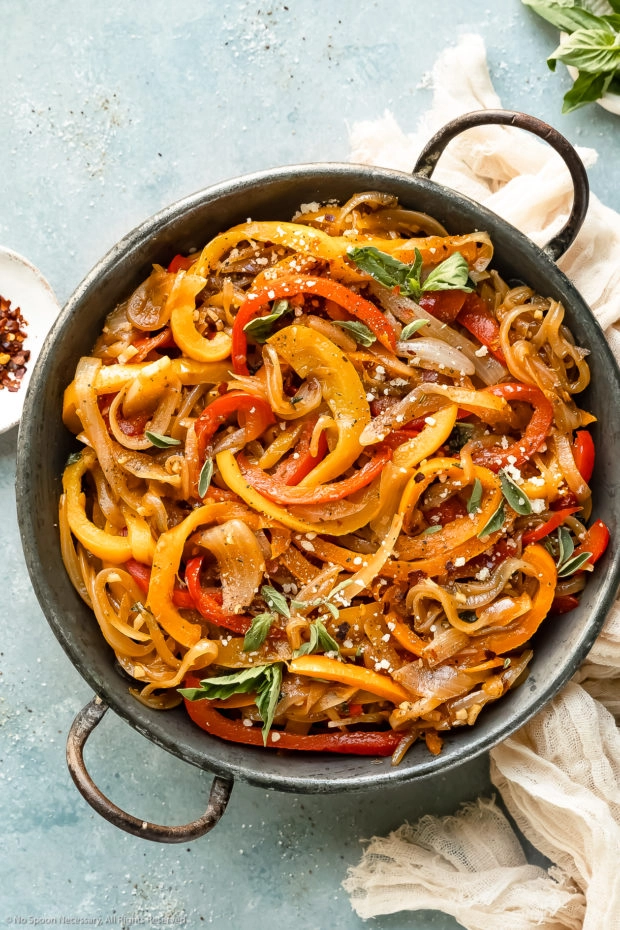
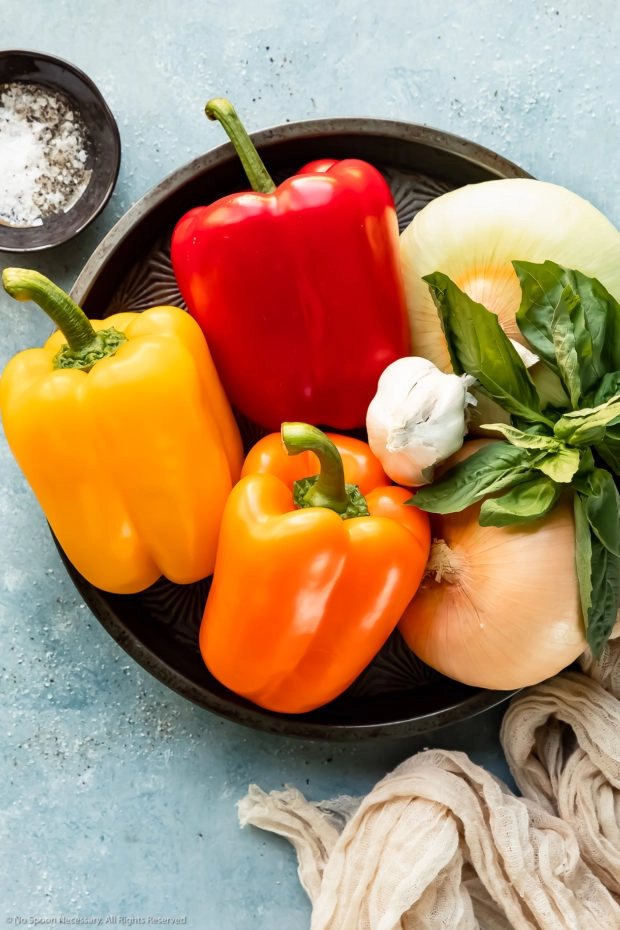
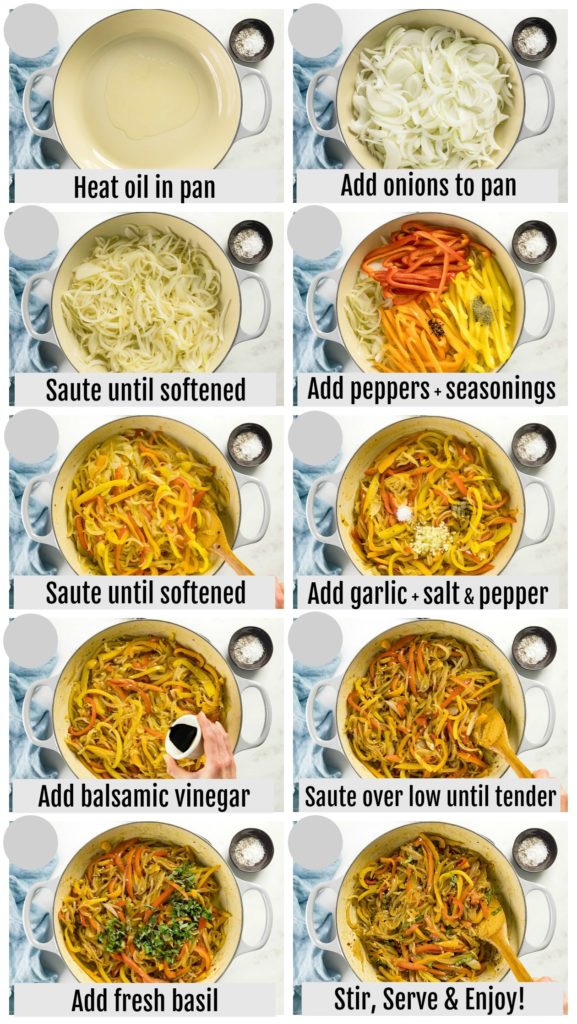
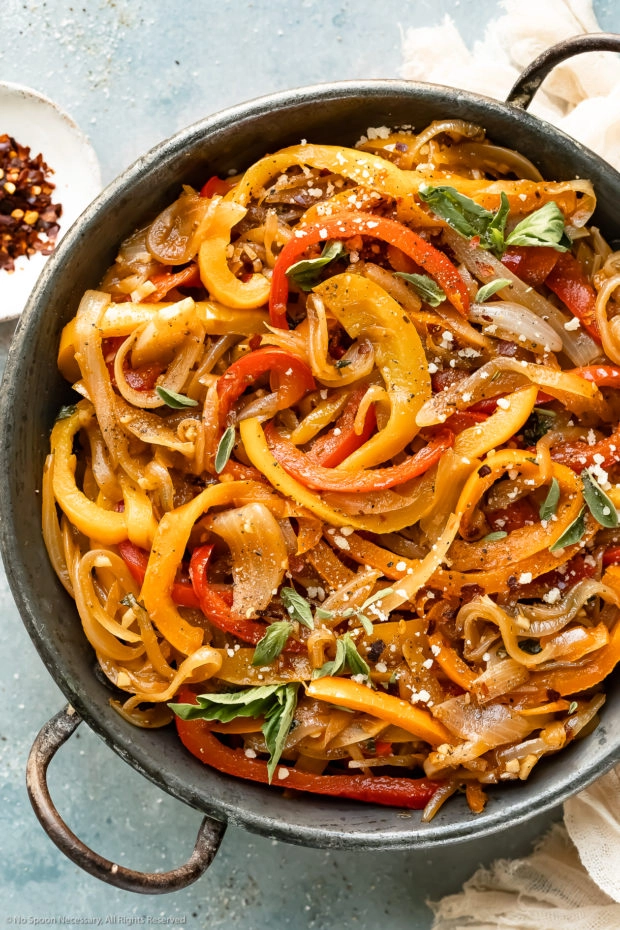
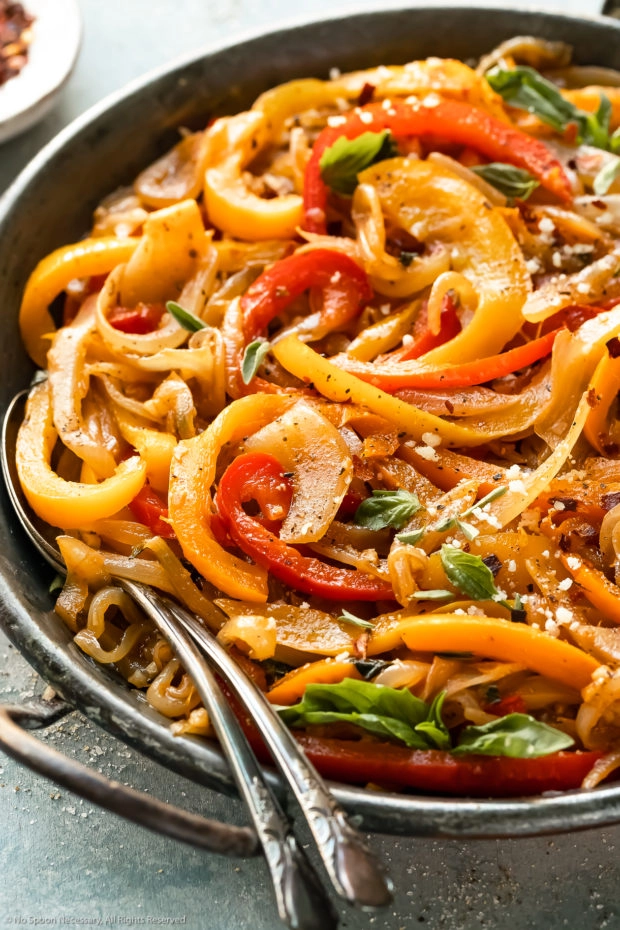
Dana Reid
Recipe sounds amazing. I love how you have shown a step by step picture based recipe…making this accessible for most individuals. I am a teacher and often search for images to help students with reading difficulties understand the recipe. Would it be ok to use some of your image based instructions (with a nod to you of course)? Thanks!
pat
Recipe Typo What amt of Kosher salt and pepper? It says 1/ What does that mean?
Cheyanne
Hi Pat,
Thank you so much for pointing that out! The precise amount of salt and pepper will always be “to taste”; however, if you look at step 3 I listed the amount to of salt and pepper to start with “season with ½ teaspoon salt and ¼ teaspoon pepper”. Everyone’s taste is dramatically different, so I always encourage you to use salt and pepper to your specific taste. I went ahead and corrected the typo in the ingredients – thank you again for bringing that to my attention!! Cheers and warm wishes for a wonderful day!
Mary Ann | The Beach House Kitchen
Great idea for a post Chey! We love sauteed peppers and onions. We would enjoy these on burgers, sausages, with our eggs for breakfast…the possibilities are endless! Pinned!
Kevin
The absolute best way to make your kitchen smell ah-mazing! Love sauteed peppers and onions for many, many, many reasons!
Marissa
I can think of about 1,000 ways to enjoy these sautéed peppers and onions, Cheyanne! To smother steak, chicken, burgers or to stuff into an omelet! Thank you for all the great tips!
Jennifer @ Seasons and Suppers
I’d love this as a side for so many things or just to pile on top of things! A great way to eat my veggies 🙂
Jeff the Chef
Sausage and peppers is one of my favorites. Thanks for the recipe.
angiesrecipes
What a delightful veggie stirfry! I have some Greek seasoning in the pantry and this would be a great recipe to use it.